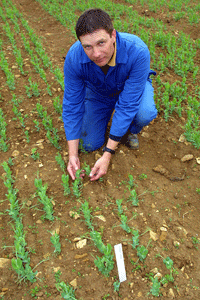Pea demand will keep prices favourable

Pea prices will remain high for 2009 as demand for quality crops continues to outstrip estimated production, growers and advisers heard at a PGRO/Syngenta workshop near Peterborough on 6 November.
Two consecutive years of falling plantings created a shortfall in supplies, keeping prices of the best samples of micronising and marrowfat peas up at £250-300/t, technical officer Stephen Belcher (pictured) said. And with the latest BEPA estimates suggesting production of all the main pea types would be less than demand in the UK (see table), that should continue to underpin high prices for the crop next season.
“Peas are really wanted by the market, and UK-grown crops have quality advantages, with 95% being suitable for premium markets,” he said.
Marrowfats were the most attractive, but to achieve the snack food premium, they needed to meet stringent requirements, including being free from marsh spot, insect damage, stones and impurities, as well as being able to soak.

“In addition, you must maintain their colour by harvesting early when they are between 18-21% moisture content.”
Yields of about 4.5t/ha could be achieved with modern marrowfat varieties, although that was lower than large blues and white peas, which yielded up to 5.2t/ha, he said.
To achieve those yields it was important to get the agronomy right, particularly with gross margins of £700/ha possible with marrowfats and micronising peas in 2009, his colleagues Anthony Biddle and Jim Scrimshaw said.
Wait until conditions were suitable before drilling, Mr Scrimshaw stressed. “Peas are one crop that won’t tolerate compaction.”
Recommended populations were 65 plants/sq m for marrowfats, 70/sq m for large blues and whites and 75-110/sq m for small blues. “The higher figure in this range applies to the early variety Zero4.”
Invest in fungicides and insecticides to protect quality, Mr Biddle said. “Yield responses more than pay usually. It’s only if the weather is favourable that you can cut back.”
If u-shaped notches were seen on seedling leaves, early pyrethroid sprays would be needed to prevent crop damage from weevils. “It’s usually worse in a cold, dry spring. The adults feed on the newly emerged plants and then lay eggs – the resulting larvae feed on the root nodules.
“Apply the pyrethroid as soon as the notches are seen. It’s important to disrupt the egg-laying period.”
UK pulse supply and demand 2009 | ||
Demand (t) | Estimated production (t) | |
Marrowfats | 60,000 | 30,000 |
Large Blues | 110,000 | 65,000 |
Yellows | 10,000 | 5,000 |
Beans | 130,000 | 115,000 |
Source: BEPA | ||
Pea aphids could reduce yields by 30% and appear from early flowering onwards. “They cause feeding damage and virus transmission. When 20% of plants are infested, you should spray.”
Botrytis could be a problem in wet weather, when petals stuck to pods and caused infection, he added. “There aren’t any curative fungicides, so you need a protectant spray.”
The same was true of leaf and pod spot. “Normal practice is to spray at first pod and again a fortnight later, at flat pod stage. If it’s warm and dry, there’s no need to spray for either of these diseases.”
An Amistar +Bravo mix was a good solution, although the second spray on marrowfats and late-maturing varieties might need to give powdery mildew protection. “If that’s the case, consider Alto Elite instead.”
Marsh spot, which was caused by manganese deficiency, could be avoided by applying manganese sulphate when the first foliar symptoms were seen. “Treat at first pod and again 10-14 days later. In a wet season, a third treatment may be required.”
But there was no excuse for pea moth problems, stressed Dr Biddle. “An excellent monitoring system is available and a two-spray programme will give good control.”
Beans |
Bean prices have not kept up with peas, but crops for the export market should be worth £130/t, while those for animal feed will command £110-120/t. |

